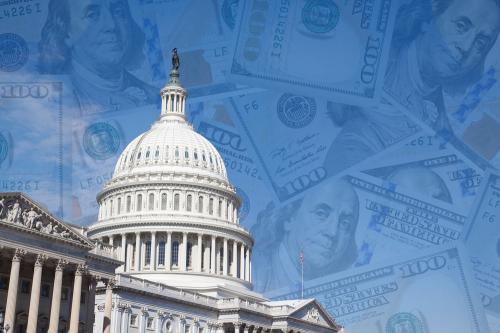A good tax system raises the revenues needed to finance government spending in a manner that is as simple, equitable, and growth-friendly as possible. The United States does not have a good tax system. Long considered an outrageous affront by many observers, the U.S. tax system has generated perennial calls for everything from minor tune-ups to comprehensive reform. As a result, there is a lot of room for the next president to improve the country’s tax code. Massive disagreement exists, however, about which issues are the most important and how they should be addressed.
We believe the best way to reform the system is to raise revenues, reform the corporate income tax, help low- and middle-income households, and redistribute the tax burden toward high-income households.
Long-term revenues should be raised as part of an overall package to stabilize America’s public debt. Entitlements need to be part of the solution as well, but they have proven difficult to reform, and discretionary spending is already slated to fall to historically low shares of GDP over the next 25 years. Increasing federal revenues does not mean that statutory marginal income tax rates have to rise. Capping the tax benefit of itemized deductions – for example, through an overall per-filer limit or a 15 cents per dollar limit – would affect mostly high-income households and raise more than 0.5 percent of GDP in revenue.
A 10 percent value-added-tax, which is a consumption tax that has administrative advantages over a national retail sales tax, could raise 2 percent of GDP in revenues, even after allowing for interactions with other taxes and cash payments to offset the hit to low-income families.
A tax on carbon would raise revenue and also make good economic sense, as it would ensure that producers and users of carbon bear the full societal cost of their actions. It could raise more than 0.5 percent of GDP according to Tax Policy Center and Congressional Budget Office estimates.
A tax on carbon would raise revenue and also make good economic sense, as it would ensure that producers and users of carbon bear the full societal cost of their actions.
Current corporate tax rules distort business choices regarding organizational choice, financing, and dividend policy. Restricting interest deductions, as emphasized by Robert Pozen and others, would reduce the bias toward debt. A totally different and radical approach would replace the corporate income tax with a tax on shareholder wealth accumulation, as proposed by Eric Toder and Alan Viard. Alternatively, Alan Auerbach proposes that the U.S. convert the corporate income tax into a corporate cash-flow tax with deductions for wages. This would encourage new investment and simplify taxes.
Under our current tax system low- and middle-income earners often face very high effective marginal tax rates even if they face low statutory marginal tax rates. For example, Kearney and Turner note that a secondary earner in a married household typically pays a higher effective tax rate on the margin than the primary earner. This issue arises because the two incomes are combined to form one tax unit even though the secondary earner often has a lower individual income than the primary earner. On both fairness and economic grounds, Kearney and Turner propose a 20 percent secondary-earner tax deduction until a cap is reached. This deduction would improve the incentive to work, provide more economic security to working low- and middle-income families, and mitigate the secondary earner penalty. Other ways to mitigate the tax burden faced by low- and middle-income earners include expanding eligibility for the Earned Income Tax Credit or transforming the Child and Dependent Care Credit to a refundable benefit.
Under our current tax system low- and middle-income earners often face very high effective marginal tax rates even if they face low statutory marginal tax rates.
There are three major reasons to increase the tax burden on high-income households. First, their income has increased dramatically over the past several decades, yet their average tax burdens as a share of income have remained relatively constant. Second, if the fiscal reforms described above are implemented, the main benefit will be economic growth, but such growth in the past several decades has accrued largely to high-income households, who should thus be expected to pay for it. Third, despite much rhetoric to the contrary, reasonable variations in taxes on high-income households do not appear to have discernible negative effects on growth. There are many ways to boost the revenue collected from high-income households. The most prominent examples include restrictions on tax expenditures, taxing capital gains at death, or a higher estate tax.
Even though the politics have been, and will continue to be, a major barrier to reform, the next president may well be judged a success or failure in significant part based on how he or she handles tax policy. It’s time to stop kicking the can down the road.
Reforming the tax system so that it pays for government spending, treats taxpayers fairly, and improves incentives for productive activity can only be a plus from an economic standpoint. Even though the politics have been, and will continue to be, a major barrier to reform, the next president may well be judged a success or failure in significant part based on how he or she handles tax policy. It’s time to stop kicking the can down the road.
The Brookings Institution is committed to quality, independence, and impact.
We are supported by a diverse array of funders. In line with our values and policies, each Brookings publication represents the sole views of its author(s).





